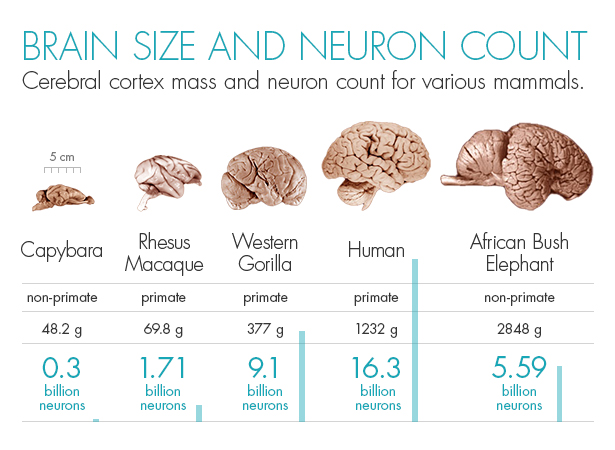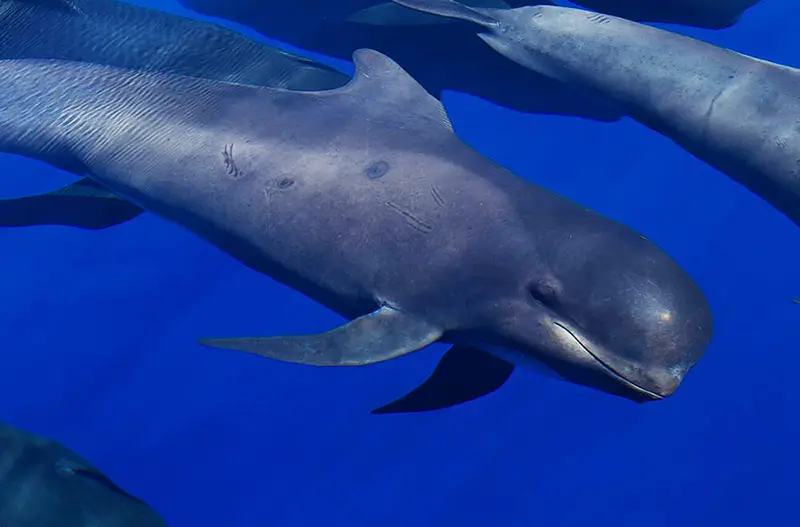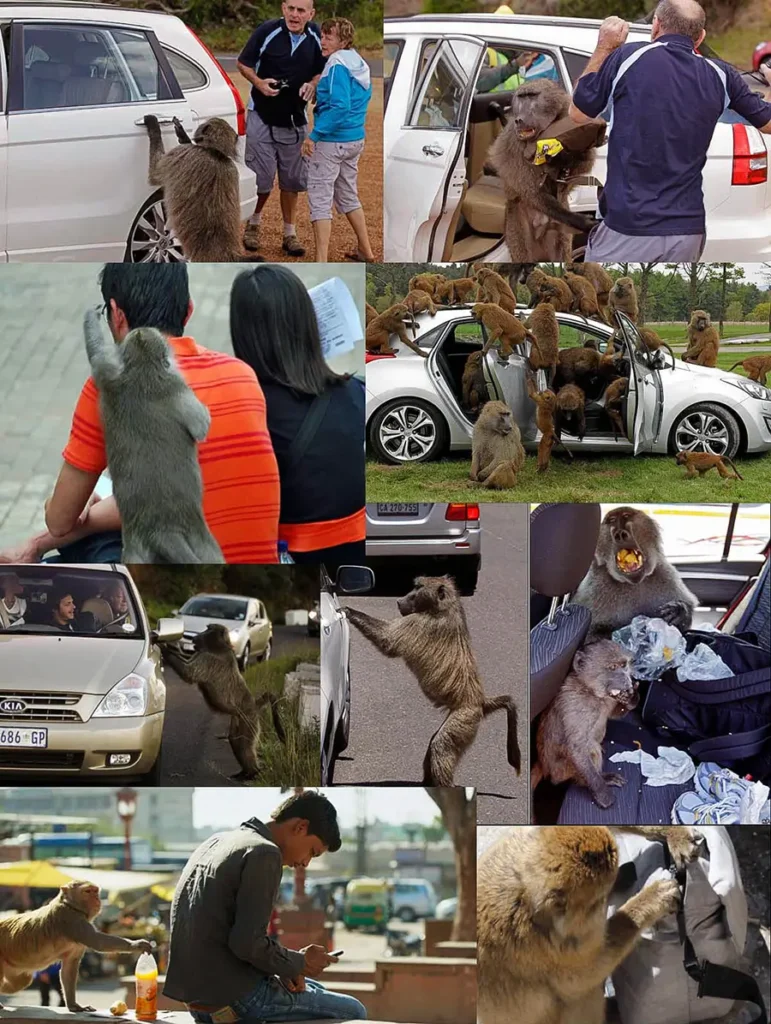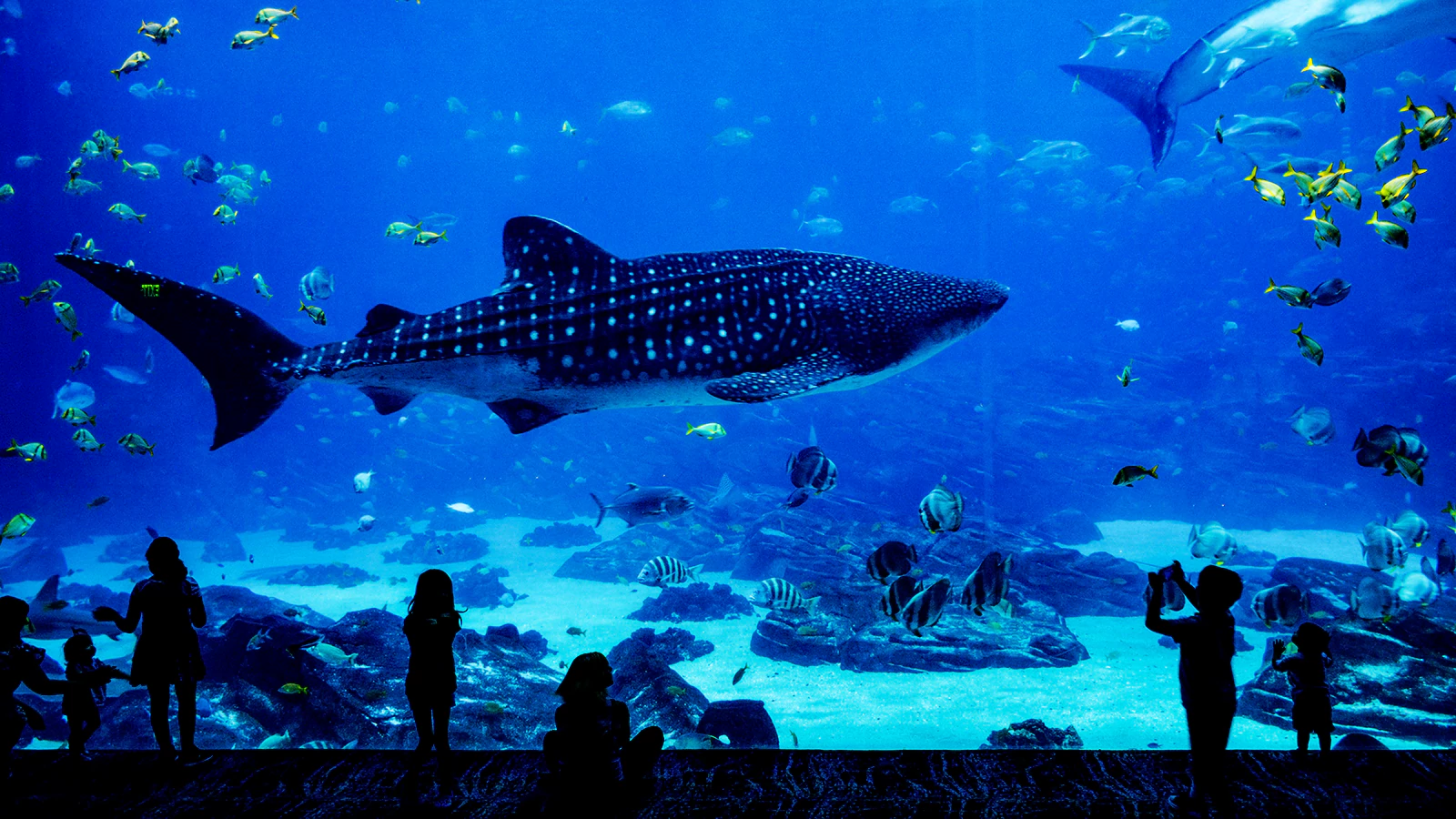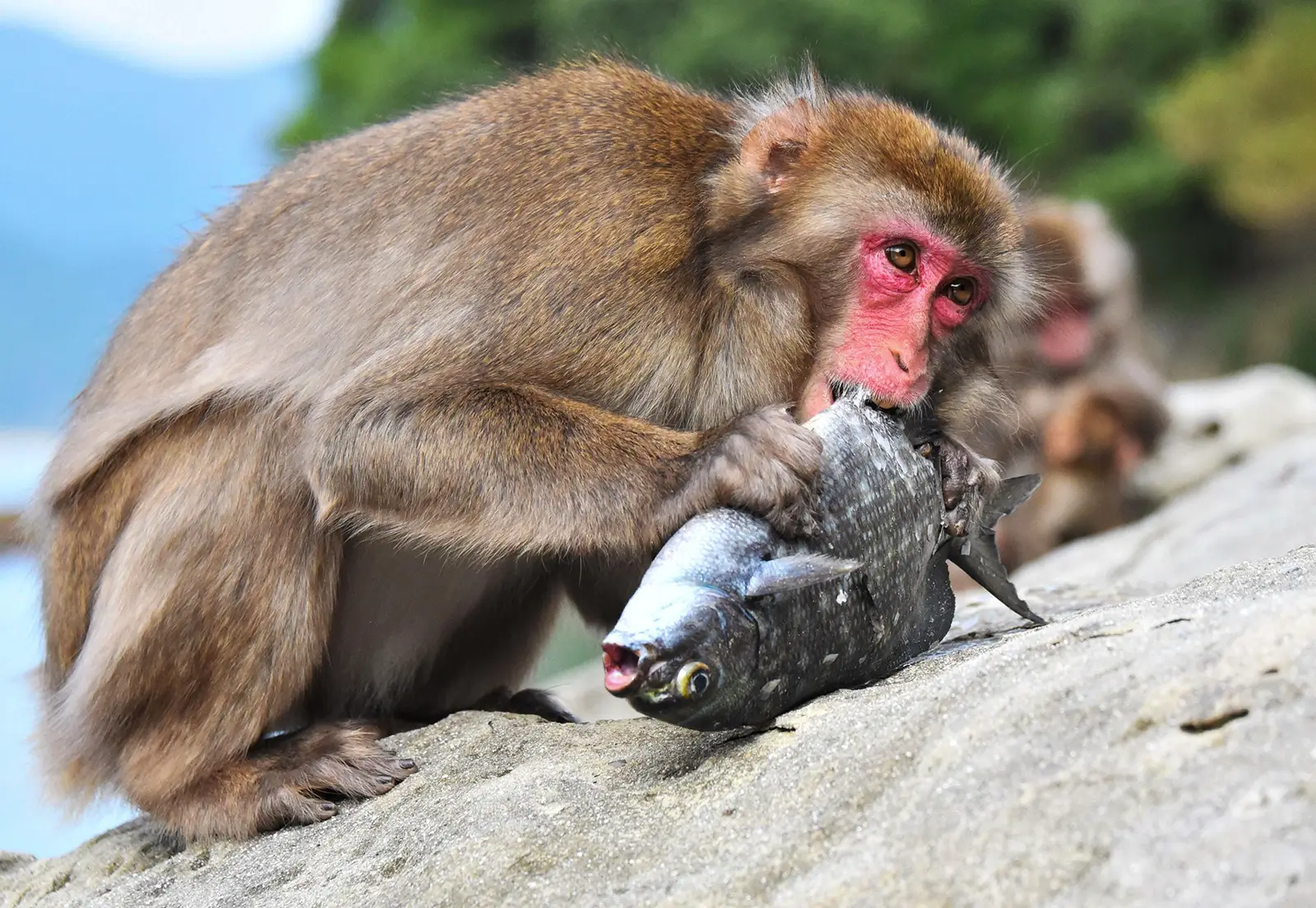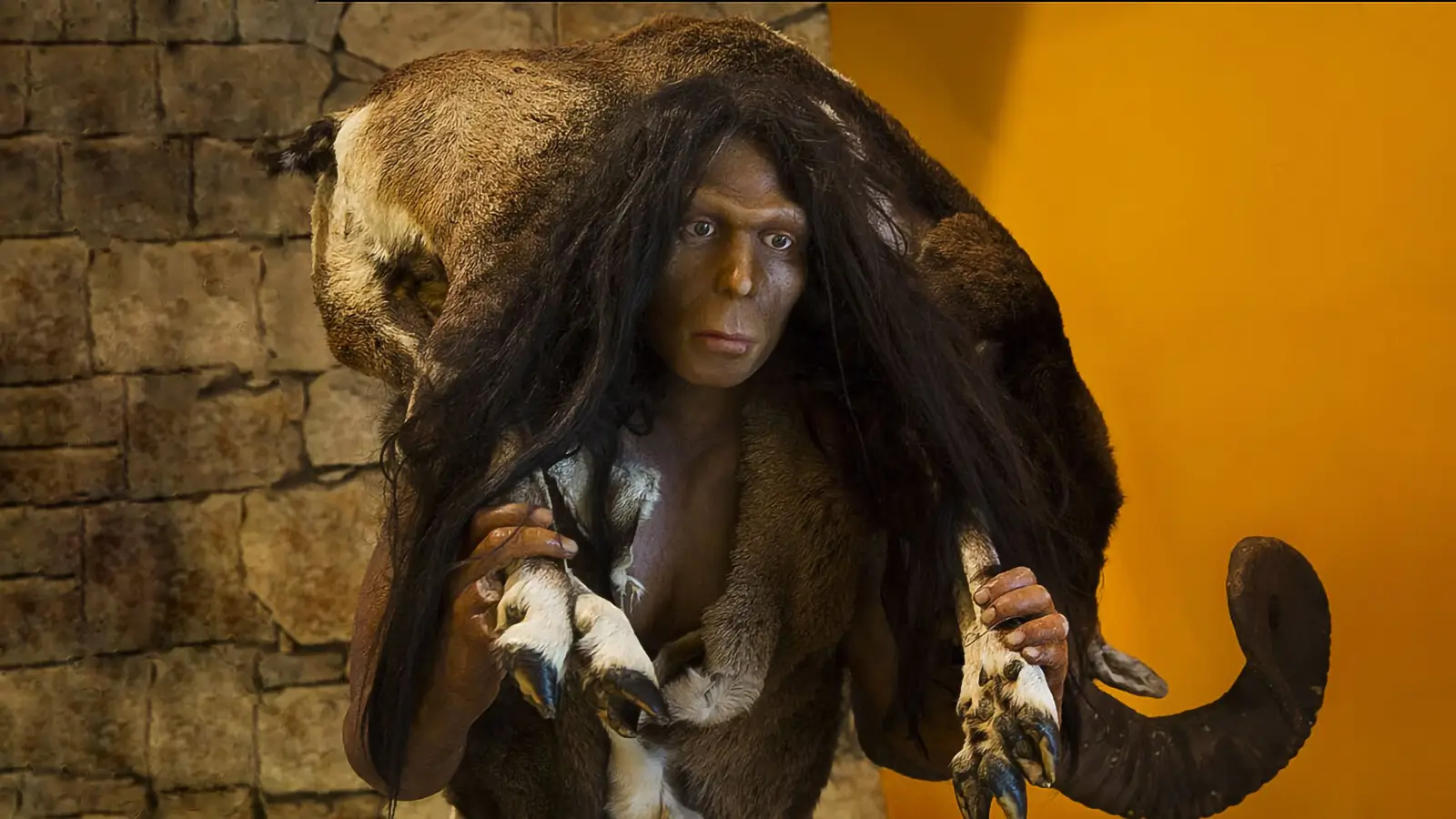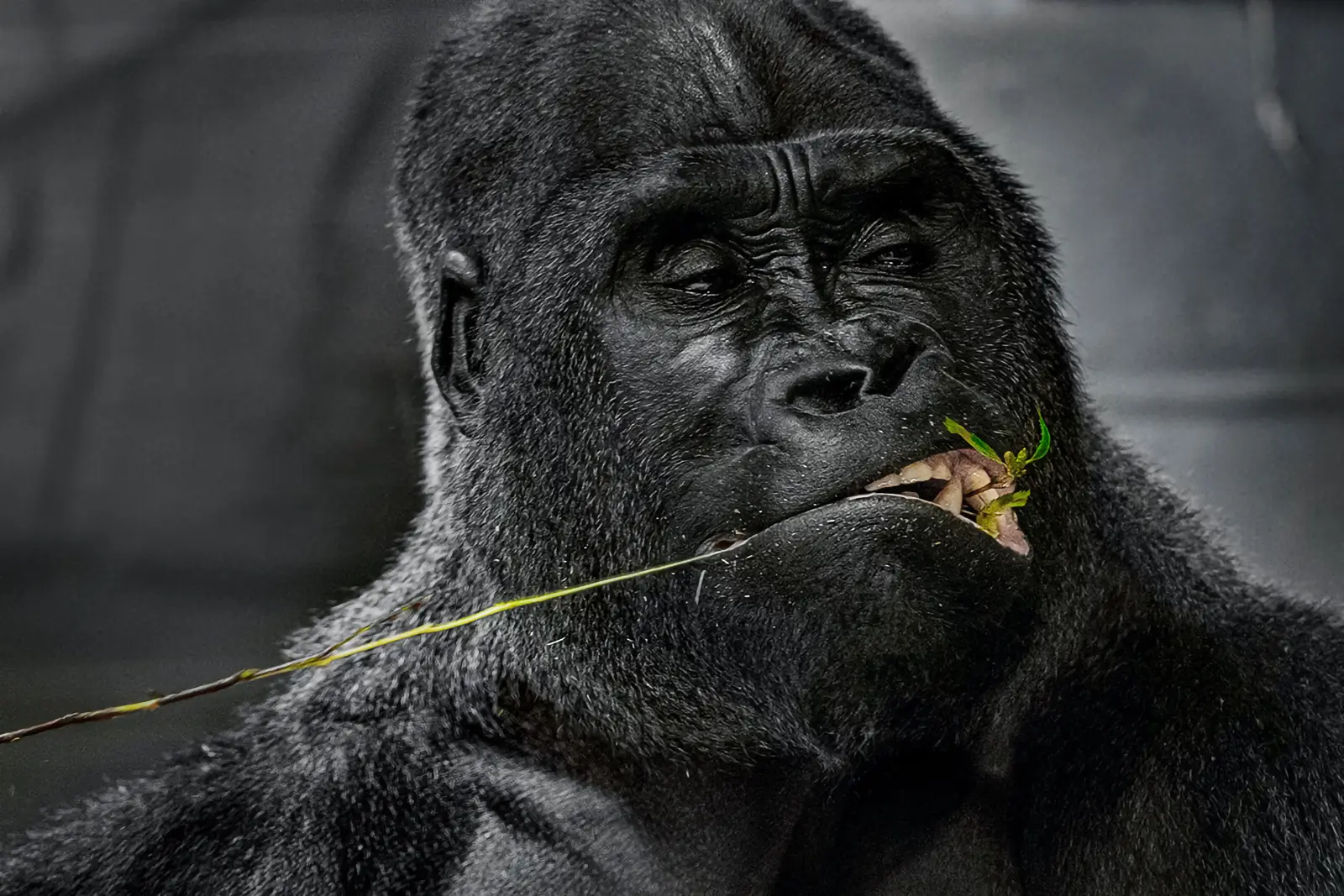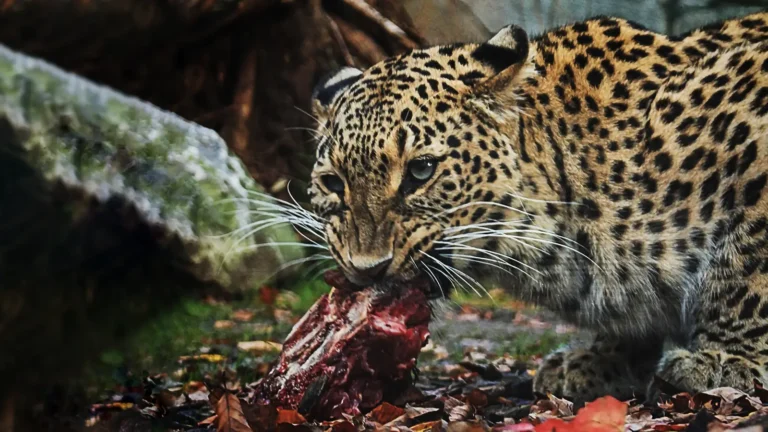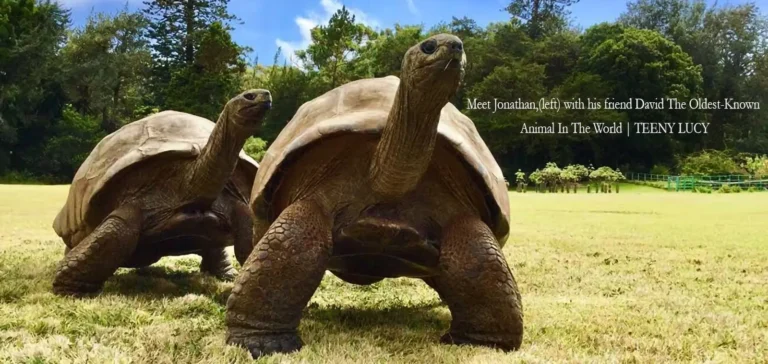Protectora de animales de carne humana o mito?- La cognición animal
No somos la especie más inteligente si medimos científicamente la cognición animal. La parte neocortical del cerebro del calderón tropical contiene más neuronas que el nuestro.
Milos Pokimica
Escrito por: Milos Pokimica
Revisado Médicamente Por: Dr. Xiùying Wáng, M.D.
Actualizado el 9 de junio de 2023¿Ha pensado alguna vez en lo que piensa su perro? ¿O cómo aprenden los delfines a cooperar para pescar? ¿O si un chimpancé podría aprender el lenguaje de signos? El campo de la ciencia que investiga la capacidad mental de los animales se llama cognición animal, que es el estudio de la mente de los animales, en particular cómo piensan y aprenden. Investiga no sólo lo que hacen los animales, sino también los procesos mentales que sustentan su comportamiento.
La cognición animal es un tema complicado. Hasta los años sesenta, el término "cognición animal" se consideraba un oxímoron, porque se pensaba que los animales eran sistemas simples que respondían a diversos estímulos de forma invariable y preprogramada evolutivamente. Sin embargo, cuando los investigadores empezaron a observar de cerca a los animales en el laboratorio y en la naturaleza, se dieron cuenta de que esta visión simplista no explicaba los patrones de comportamiento observados. Aunque hay tantas definiciones de la cognición animal como investigadores, la mayoría de los científicos coinciden en que la cognición animal, al igual que la humana, consiste esencialmente en el procesamiento de la información: cómo un sujeto, dentro de su sistema perceptivo específico de especie (auditivo, visual, olfativo, gustativo, somatosensorial), recibe datos del mundo que habita (incluidos los datos de otros individuos) y utiliza su cerebro para procrear utilizando su neurobiología específica de especie. En las últimas décadas, el estudio de la cognición animal se ha ampliado hasta incluir un abanico asombrosamente diverso de especies, desde insectos hasta nuestros parientes más cercanos y primates no humanos, así como una amplia gama de técnicas.
Este campo puede subdividirse en varios subtemas. Los investigadores especializados en psicología comparada, por ejemplo, examinan un tipo específico de cognición, como la competencia numérica, en diversas especies, mientras que los investigadores especializados en etología cognitiva estudian cómo los rasgos evolutivos de una especie concreta le permiten interactuar de diversas formas con uno o más aspectos de su entorno. Como en todos los estudios intervienen diversos aspectos de la atención, la categorización, la memoria, el razonamiento y la resolución de problemas, la mayoría de los investigadores realizan estudios que solapan varios subtemas diferentes, y a veces las respuestas a las preguntas científicas sólo pueden encontrarse combinando la investigación de laboratorio y la de campo. En todos los casos, los científicos realizan experimentos cuidadosamente controlados o estudios de observación bien planificados.
Hoy en día tenemos una línea de estudios pero en un pasado no tan lejano incluso el término cognición animal fue negado hasta el punto de que incluso el comportamiento similar al humano en los primates se consideraba un desencadenamiento instintivo sin inteligencia. Los humanos eran la única especie inteligente, los humanos eran la única especie en el planeta Tierra que tenía alma, y Dios hizo la imagen de sí mismo en ellos, los humanos están aquí para gobernar y todos los animales sin importar su nivel de inteligencia sólo están ahí para ser una fuente de alimento. Esta opinión todavía prevalece en la mayoría de la población y uno de los mitos que todavía existen es que todo esto se debe a que de alguna manera crecimos un cerebro más grande en la edad de piedra cuando empezamos a comer carne como una fuente adicional de proteínas y energía que permitió que nuestro cerebro creciera.
El problema con esta creencia es que no hay ninguna relación particular entre el tamaño del cerebro y la inteligencia en primer lugar, e incluso si hay una historia sobre la cognición animal en realidad no es realmente una historia sobre la carne consumo o el consumo humano de carne. Es más complicado que eso.
Los adultos humanos tienen alrededor de 3 libras de peso cerebral, los delfines 3,5 libras, un elefante alrededor de 10,5 y los cachalotes alrededor de 17,2 libras. Por regla general, los depredadores suelen tener el cerebro relativamente más grande que los animales que son sus presas. Los mamíferos placentarios también suelen tener el cerebro más grande que los marsupiales, como la zarigüeya. Existe una fórmula conocida como cociente de encefalización para medir el tamaño del cerebro de la especie en relación con las expectativas basadas en su tamaño corporal previsto. A lo largo de toda la evolución del Homo sapiens, el rasgo predominante fue un aumento constante del tamaño del cerebro. Lo cierto es que gran parte de ese tamaño puede atribuirse a los correspondientes aumentos del tamaño corporal. Los neandertales, por ejemplo, y mucha gente no lo sabe, tenían cerebros más grandes que los Homo sapiens modernos. Lo que es más importante que el tamaño es cómo está conectado el cerebro y el número de neuronas.
Lo que hace único al cerebro humano es que el recuento de neuronas en una parte específica del cerebro llamada corteza cerebral es mucho mayor que en cualquier otro animal de la Tierra. El cerebro humano tiene 86.000 millones de neuronas si las contamos todas: 69.000 millones en el cerebelo, 16.000 millones en la corteza cerebral y 1.000 millones en el tronco encefálico y sus prolongaciones hasta el núcleo del cerebro. El cerebelo orquesta las funciones corporales esenciales y el movimiento y es una parte primitiva del cerebro, o digamos una parte esencial. La corteza cerebral es la corona gruesa del cerebro, el verdadero cerebro. Es responsable de la autoconciencia, el lenguaje, la resolución de problemas, los talentos mentales sofisticados y el pensamiento abstracto. Si queremos medir la inteligencia de la especie, tenemos que contar las neuronas de la corteza cerebral. Y ya está. Así de sencillo. Por ejemplo, el cerebro de un elefante es tres veces más grande que el nuestro y tiene 251.000 millones de neuronas en el cerebelo, necesarias para manejar su enorme trompa, pero sólo 5.600 millones en el córtex. Para que quede claro, el elefante se considera una especie muy inteligente. Si nos fijamos en los grandes simios, salimos ganando. Tenemos 16.000 millones de neuronas en nuestro córtex, pero sólo me refería a los grandes simios. El homo sapiens parece tener el mayor número de neuronas corticales de todas las especies de la Tierra.
Oh, espera. Acabo de mentir. No somos los más inteligentes. El calderón tropical lo es. Su parte neocortical del cerebro contiene bastantes más neuronas y células gliales que el neocórtex de otras especies de cerebro grande, incluidos los humanos (Mortensen y otros, 2014).
Somos la especie más inteligente si sólo contamos las especies animales terrestres, y tenemos brazos y piernas y habla para poder construir tecnología, pero adivina qué, según estas mediciones, no somos la especie más inteligente de la Tierra. Lo es el calderón tropical.
El mayor número de neuronas en la corteza cerebral es lo que hace inteligentes a las especies. Los primates desarrollaron una forma de empaquetar muchas más neuronas en esa zona que otros mamíferos. Los grandes simios son diminutos en comparación con los elefantes y las ballenas, pero su corteza cerebral es mucho más densa. Los orangutanes y los gorilas tienen 9.000 millones de neuronas corticales, y los chimpancés, 6.000 millones. Así que, según estas medidas, los humanos somos 44% más inteligentes que los orangutanes, por ejemplo, porque tenemos 16.000 millones de neuronas y ellos 9. Por tanto, si el coeficiente intelectual medio de los humanos es 100, el de los orangutanes sería 56. Los chimpancés suelen estar entre 35 y 50. No está nada mal. Incluso los monos pequeños son muy inteligentes y más que su homólogo en tamaño. El hecho de tener que pensar cada vez que necesitamos comer obliga al cerebro a desarrollar estrategias de búsqueda de alimentos. Pondré un ejemplo. En lugares como Sudáfrica o la India, hay un gran número de monos urbanos. Estos animales salvajes llegaron por voluntad propia a las ciudades en busca de comida. En su opinión, no somos más que otra especie de monos. No nos tienen ningún miedo. Consideran que no les asustamos porque somos más lentos que ellos y, en gran medida, más débiles, y tenemos toda esa comida por todas partes. Para los monos salvajes, es más fácil buscar comida en el entorno humano. Los perros callejeros lo hacen olfateando la comida, utilizan el olfato, pero los monos usan el cerebro para hacer lo mismo. Debido a las películas y a la cultura media, es probable que los norteamericanos piensen que los monos son animales dulces y simpáticos con los que pueden divertirse y que son súper monos cuando llevan ropa humana. En la vida real, son de todo menos monos. Por ejemplo, se sabe que vagan por los barrios en bandas. Las bandas de babuinos son salvajes en partes del mundo como los suburbios de Sudáfrica. Viajan en bandadas de unos 30 ejemplares, y todos se mueven siguiendo al líder, pero están tan separados que es difícil impedir que se cuelen en zonas urbanizadas. Pueden atravesar muros y tejados a gran velocidad. Las bandas siempre tienen un líder, y van en busca de tus cosas. Allanamiento de morada, comportamiento agresivo y robo. La vida habitual de los matones y no tiene ninguna gracia. Entran en las casas de la gente para robar comida, y entran en los coches, y saben cómo abrir las puertas o cualquier otra cosa de esa manera. Si te ven hacerlo, ellos también pueden. Son muy inteligentes.
Pensemos en esto. Los monos de cerebro pequeño pueden ver cómo utilizas la tecnología y entonces pueden empezar a utilizarla también para ellos. Aprenden por sí mismos a abrir ventanas, a abrir puertas de coches, frigoríficos y apartamentos, pueden escabullirse a tus espaldas y robar, pueden desabrochar cremalleras, etcétera.
No sólo son conscientes de sí mismos, sino también de tu forma de pensar para poder ponerse en tu lugar y predecir cómo vas a reaccionar para poder manipularte. No bromeo. Son conocidos por escabullirse a tus espaldas y robarte cosas, y son conocidos por engañarte.
Uno de ellos robará delante de ti y empezará a correr y cuando salgas a perseguirlo otros monos que no viste entrarán y robarán cosas mientras persigues a ese único. Esto no es cognición animal, es cognición en toda regla. Y si eso no es suficiente, te lo quitarán de las manos físicamente. Si tienes algún problema, te abofetearán. No nos tienen miedo. Y podemos decir que eso ya es bastante malo, pero hay más. Cuando se aburren, van a pasar el rato rodeados de gente y a darse placer. El teniente de alcalde de Nueva Delhi murió por el ataque de un mono. No directamente, no le atacaron a él, sino que tropezó por el balcón cuando intentaba echarlos de su apartamento. Son agresivos e inteligentes. Según un estudio (Grainger et al., 2012), los babuinos no tienen lenguaje conocido ni nada parecido, pero fueron capaces de separar con precisión palabras inglesas reales de secuencias de letras sin sentido. Si los babuinos tienen la capacidad física de hablar, su nivel de cognición animal es tal que tendrán un lenguaje escrito real porque tienen la inteligencia adecuada para ello, ya que la capacidad de distinguir palabras reales de las que no lo son es el primer paso en el proceso de lectura.
Comparemos, por ejemplo, especies de monos herbívoros con especies carnívoras de aproximadamente el mismo tamaño. En el documental "Animals Like Us" los cineastas documentaron el secuestro de cachorros de perros salvajes por parte de babuinos y su cría en su propia tribu de babuinos como miembros o mascotas. Los babuinos y los perros tienen tamaños similares. El clip de la serie, que se filmó en un vertedero cerca de Ta'if (Arabia Saudí), muestra a un babuino macho arrastrando a un cachorro lejos de su madriguera mientras grita llamando a su madre. Los perros robados crecen con la especie de los babuinos, como un miembro más de la familia o de un grupo. Comen con ellos, duermen y se mueven juntos. Los babuinos los acicalan y juegan con ellos, y eso es importante. Los babuinos sólo juegan con miembros de la familia. La relación parece beneficiar tanto al perro como al babuino. Los perros asilvestrados domesticados desempeñan la misma función que en la sociedad humana: vigilar el territorio. Mantienen a las manadas de perros salvajes alejadas de los monos por la noche mientras duermen y, a cambio, se les trata con cariño y cuidado igual que los humanos tratarían a una mascota de la familia. Nótese que en esta situación es importante entender que los perros tenían más bien un estatus de igualdad en la tribu, no eran mascotas ya que los monos no los alimentaban. Los perros son carnívoros y comen ratas y otros animales pequeños y la carne que encuentran. Ellos no comerían frutas y verduras y otros granos y otros alimentos en el vertedero de origen vegetal que los babuinos comerían. No había competencia directa por los alimentos por lo que tienen una tribu común en una relación simbiótica. Ahora bien, este vídeo suscitó muchas controversias. A la gente le cuesta aceptar un comportamiento similar al humano en los animales debido a la imagen que tenemos de nosotros mismos. Si existía un vínculo familiar entre los babuinos y los perros, no lo sabremos hasta que se realice una investigación real y científica. Ha aparecido otro vídeo en el que un babuino maltrata a un cachorro. Lo grabó un estudiante de Cornell llamado Luke Seitz. Estaba en un viaje de investigación sobre aves en Etiopía cuando grabó una situación similar de un babuino llevando a un perro "como si fuera una mascota". Al parecer, también observó este comportamiento durante varios días, por lo que no fue una casualidad.
En otro caso, en la meseta de Guassa (Etiopía), el primatólogo Vivek Venkataraman observó una escena sorprendente: lobos y monos mezclándose casualmente. En circunstancias normales, los monos son presas, pero en esta situación, los lobos no parecían tener interés en comerse a los babuinos. Los babuinos, y especialmente los jóvenes, son presa fácil para los lobos. De hecho, parecían hacer todo lo posible por eludir cualquier enfrentamiento. Se ignoraban unos a otros y pasaban horas deambulando entre las grandes manadas de geladas en busca de roedores. Como no compiten por una fuente primaria de alimento y atacar a la gran colonia de monos acabaría en guerra y les pasarían cosas malas a ambos, cohabitan. Los humanos y los gatos salvajes tenían este tipo de acuerdo. La domesticación de los gatos salvajes ocurrió al mismo tiempo en Oriente Medio y Egipto. Los gatos salvajes empezaron a pasar mucho tiempo en las aldeas humanas. Había muchas ratas presentes debido a la acumulación de granos tras la domesticación de las plantas silvestres. Era la misma relación simbiótica. Utilizábamos a los gatos salvajes para reducir el número de ratas; nos beneficiaba tolerarlos. No las alimentábamos directamente. Además, las ratas pueden atraer a otros depredadores como las serpientes, y eso puede ser mortal. Así que toleramos a los gatos salvajes, y los gatos salvajes nos toleraron a nosotros porque somos la fuente de su nueva abundancia de comida y con el tiempo se produjo la domesticación. Los monos también son conocidos por adoptar a las personas.
Cuando era una niña de apenas cinco años, Marina Chapman fue secuestrada. Un posible motivo fue pedir rescate, pero al no obtenerlo, los delincuentes se limitaron a abandonarla en la selva colombiana. Durante unos cinco años vivió en la naturaleza. Cuenta que la acogió un grupo de monos capuchinos. Este tipo de monos son conocidos por aceptar niños pequeños en su redil. Aprendió a buscar comida imitándoles. Dice que los monos le enseñaron a hacerlo pero, en cualquier caso, sobrevivió. Volvió a la civilización humana cuando fue recogida por cazadores y vendida a un burdel (en ese momento no era capaz de hablar la lengua humana). Finalmente consiguió escapar del burdel, vivió en las calles y al final se convirtió en esclava de la familia mafiosa.
La carne humanitaria es un mito justamente humanitario. No importa si hablamos de pollos, cerdos o cualquier otro animal. Los cerdos son al menos tan inteligentes como un niño humano de tres años, las vacas desarrollan vínculos profundos y duraderos con su familia y amigos, los pollos son capaces de distinguir más de 100 caras distintas de los miembros de su especie y tienen 30 llamadas diferentes para señalar distintos trastes. La cognición animal es un tema muy amplio.
De Kanzi, el bonobo, a Akeakamai, el delfín. Kenzi, por ejemplo, aprendió más de 500 lexigramas. Y lo que es más importante, era capaz de conectar estos lexigramas para representar la forma de pequeñas frases. En un estudio realizado en 1993, respondió a peticiones verbales mejor que un niño humano de dos años.
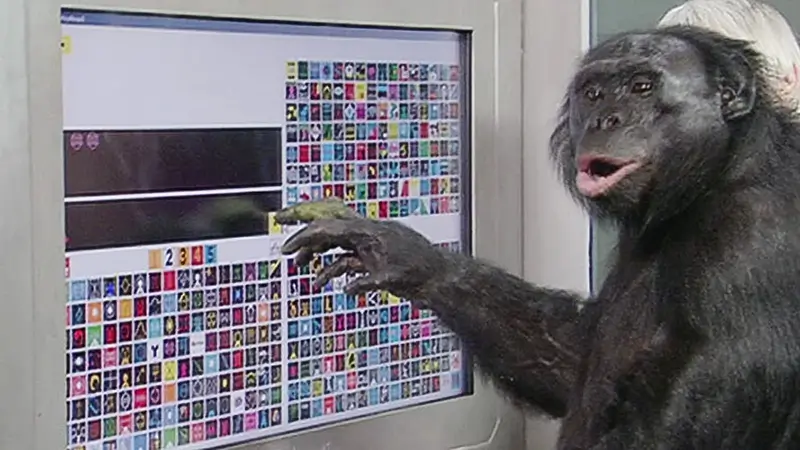
Akeakamai y Phoenix (Wikipedia), su delfín compañero de tanque, aprendieron a reconocer palabras. A Akeakamai se le enseñaron palabras representadas por diferentes gestos realizados por las manos de un entrenador humano. Phoenix aprendió escuchando palabras a través de sonidos electrónicos generados por ordenador. Estos sonidos se reproducían a través de un altavoz subacuático. Ambos delfines aprendieron con éxito palabras sueltas y, con el tiempo, cadenas de palabras o frases. De manera impresionante, los delfines podían entender las instrucciones dadas con diferentes estructuras gramaticales y diferentes órdenes de palabras. Entendían la diferencia entre instrucciones como "Lleva el aro a la pelota" y "Lleva la pelota al aro". Cuando realizaban correctamente las acciones requeridas, los delfines demostraban que entendían los elementos del lenguaje. Esto es inteligencia al nivel de los humanos. Y lo que es aún más sorprendente, los delfines parecían capaces de colaborar creativamente. Los responsables humanos pidieron a los delfines que idearan juntos sus propios trucos, utilizando el tándem y creando órdenes. Los delfines respondían con un comportamiento sincronizado de su elección, como zambullirse hacia atrás o retorcer la cola. Militares de todo el mundo incluso entrenaron y experimentaron con delfines con la idea de crear soldados a partir de ellos. El nivel de cognición de los delfines es muy parecido al de los humanos. Sin embargo, este hecho es irrelevante para nosotros.
La cognición no tiene nada que ver
No somos la única especie inteligente y si nos fijamos en los babuinos y los perros, uno herbívoro y otro carnívoro, los babuinos son más inteligentes con diferencia. Además, el propio perro es un animal muy inteligente. Es un gran dogma en la ciencia que de alguna manera la fuente de carne recién incorporada igual a un par de por ciento de las calorías totales consumidas en forma de médula ósea en la dieta de los primeros homínidos desarrolló nuestro gran cerebro y que la carne es esencial para nuestra inteligencia y tiene que ser una parte integral de la dieta moderna.
Al mismo tiempo, no queremos reconocer ninguna forma de cognición animal. La cognición animal es un tema que será cada vez más importante a medida que avancen las neurociencias. La cognición animal se encuentra hoy en una comprensión científica que el antropomorfismo ya no es un término dogmático y hoy los científicos rechazan tal lenguaje. Hoy en día, los científicos implicados en el campo de la cognición animal creen que todos los animales experimentan emociones, por ejemplo. No sólo eso, sino que las emociones son vitales para su supervivencia. En el futuro, la cognición animal también desempeñará un papel en nuestras propias percepciones y tendremos que responder a algunas preguntas concretas.
¿Concederemos derechos humanos a algunas especies de animales? Si lo hiciéramos, ¿cuáles serían las consecuencias? ¿Hasta dónde debe llegar la cognición animal para que consideremos a un animal candidato a los derechos humanos? ¿Consideraríamos la muerte de un cuervo como la de un niño humano de 7 años y, si no, por qué no? ¿Dejaríamos de experimentar con primates? ¿Dejarían los japoneses de matar y comer carne de delfín? ¿Encarcelaríamos a las personas que torturan y matan animales? ¿Qué pasa con las especies animales que consideramos fuente de alimento?
Referencias:
- Mortensen, H. S., Pakkenberg, B., Dam, M., Dietz, R., Sonne, C., Mikkelsen, B., & Eriksen, N. (2014). Relaciones cuantitativas en el neocórtex delphinid. Fronteras de la neuroanatomía, 8, 132. https://doi.org/10.3389/fnana.2014.00132
- Grainger, J., Dufau, S., Montant, M., Ziegler, J. C., & Fagot, J. (2012). Procesamiento ortográfico en babuinos (Papio papio). Ciencia (Nueva York, N.Y.), 336(6078), 245-248. https://doi.org/10.1126/science.1218152
Contenidos Relacionados
¿Tienes alguna duda acerca de la nutrición y la salud?
Me encantaría saber de usted y responderlas en mi próxima publicación. Agradezco sus aportes y opiniones y espero tener noticias suyas pronto. También te invito a síguenos en Facebook, Instagram y Pinterest para más contenidos sobre dieta, nutrición y salud. Puedes dejar un comentario allí y conectar con otros entusiastas de la salud, compartir tus consejos y experiencias, y recibir apoyo y ánimo de nuestro equipo y nuestra comunidad.
Espero que este post le haya resultado informativo y ameno y que esté preparado para aplicar los conocimientos adquiridos. Si le ha resultado útil, por favor compártelo con tus amigos y familiares que también podrían beneficiarse de ella. Nunca se sabe quién puede necesitar orientación y apoyo en su camino hacia la salud.
– También Te Puede Interesar –

Aprenda Sobre Nutricion
Milos Pokimica es doctor en medicina natural, nutricionista clínico, escritor sobre salud médica y nutrición y asesor en ciencias de la nutrición. Autor de la serie de libros Go Vegan? Revisión de la Ciencia, también dirige el sitio web sobre salud natural GoVeganWay.com.
Descargo De Responsabilidad Médica
GoVeganWay.com le ofrece reseñas de las últimas investigaciones relacionadas con la nutrición y la salud. La información proporcionada representa la opinión personal del autor y no pretende ni implica sustituir el asesoramiento, diagnóstico o tratamiento médico profesional. La información proporcionada tiene fines informativos únicamente y no pretende sustituir la consulta, el diagnóstico y/o el tratamiento médico de un médico o proveedor de atención médica calificado.NUNCA ignore el CONSEJO MÉDICO PROFESIONAL O RETRASAR la BÚSQUEDA de TRATAMIENTO MÉDICO a CAUSA DE ALGO QUE HAYA LEÍDO EN O accesibles a TRAVÉS de GoVeganWay.com
NUNCA APLICAR CUALQUIER cambio de ESTILO de vida O CAMBIOS EN su totalidad COMO UNA CONSECUENCIA DE ALGO QUE HA LEÍDO EN GoVeganWay.com ANTES de CONSULTAR con LICENCIA PROFESIONAL MÉDICO.
En el caso de una emergencia médica, llame a un médico o al 911 inmediatamente. GoVeganWay.com no se recomienda ni aprueba ninguna de los grupos, las organizaciones, las pruebas, los médicos, productos, procedimientos, opiniones u otra información que pueda ser mencionado en el interior.
Selecciones del editor –
Milos Pokimica es escritor especializado en salud y nutrición y asesor en ciencias nutricionales. Autor de la serie de libros Go Vegan? Revisión de la Ciencia, también dirige el sitio web sobre salud natural GoVeganWay.com.
Últimos artículos -
Top Noticias De Salud — ScienceDaily
- Scientists found a way to help aging guts heal themselvesen enero 4, 2026
Researchers have discovered a way to help aging intestines heal themselves using CAR T-cell therapy. By targeting senescent cells that build up over time, the treatment boosted gut regeneration, reduced inflammation, and improved nutrient absorption in mice. It even helped protect the intestine from radiation damage, with benefits lasting up to a year. Early results in human intestinal cells suggest the approach could one day improve gut health in older adults and cancer patients.
- A weak body clock may be an early warning for dementiaen enero 4, 2026
Your daily rhythm may matter more for brain health than previously thought. Older adults with weaker, more disrupted activity patterns were far more likely to develop dementia than those with steady routines. A later daily energy peak was also linked to higher risk. The study points to the body clock as a possible early warning sign for cognitive decline.
- The hidden timing system that shapes how you thinken enero 3, 2026
The brain constantly blends split-second reactions with slower, more thoughtful processing, and new research shows how it pulls this off. Scientists discovered that brain regions operate on different internal clocks and rely on white matter connections to share information across these timescales. The way this timing is organized affects how efficiently the brain switches between activity patterns tied to behavior. Differences in this system may help explain why people vary in cognitive ability.
- Scientists tested intermittent fasting without eating less and found no metabolic benefiten enero 3, 2026
Time-restricted eating has been widely promoted as a simple way to boost metabolic health, but new research paints a more complicated picture. When calorie intake stayed the same, an eight-hour eating window did not improve insulin sensitivity or cardiovascular markers. What did change was the body’s internal clock, which shifted based on meal timing and altered sleep patterns. The results suggest calorie reduction, not the eating window itself, may be the real driver of health benefits.
- Age does not stop nerve healing after spinal cord injuryen enero 3, 2026
As spinal cord injuries increasingly affect older adults, new research reveals a surprising pattern in recovery. The study shows that aging does not appear to slow the healing of nerves themselves, with older patients regaining strength and sensation at rates similar to younger people. However, age makes a clear difference in how well people recover everyday abilities like walking, mobility, and self-care.
- New antibiotic pill shows promise against drug-resistant gonorrheaen enero 3, 2026
A one-dose oral drug called zoliflodacin has proven highly effective against gonorrhoea in a major international trial. The pill matched the success of current treatments while avoiding injections and complex dosing. As antibiotic resistance spreads, this new option could make treatment simpler and more accessible worldwide. Approval could mark a major step forward in controlling a stubborn global STI.
- Scientists discover why mental disorders so often overlapen enero 3, 2026
A massive global genetics study is reshaping how we understand mental illness—and why diagnoses so often pile up. By analyzing genetic data from more than six million people, researchers uncovered deep genetic connections across 14 psychiatric conditions, showing that many disorders share common biological roots. Instead of existing in isolation, these conditions fall into five overlapping families, helping explain why depression, anxiety, PTSD, bipolar disorder, schizophrenia, and substance […]
PubMed, #Dieta vegana –
- Vegetarian Dietary Patterns for Adults: A Position Paper of the Academy of Nutrition and Dieteticsen diciembre 31, 2025
It is the position of the Academy of Nutrition and Dietetics that, in adults, appropriately planned vegetarian and vegan dietary patterns can be nutritionally adequate and can offer long-term health benefits such as improving several health outcomes associated with cardiometabolic diseases. Vegetarian dietary patterns exclude meat, poultry, and seafood, and vegan dietary patterns exclude all foods of animal origin. Registered dietitian nutritionists (RDNs) and nutrition and dietetics…
- Impact of alpha-linolenic acid supplementation on long-chain n-3 fatty acid profiles in Western, flexitarian, vegetarian, and vegan dietsen diciembre 31, 2025
CONCLUSION: In conclusion, flaxseed oil supplementation combined with a controlled diet effectively improves n-3 LCPUFA status irrespective of habitual diet. The extent of relative improvement was primarily determined by baseline EPA concentrations.
- Academy of Nutrition and Dietetics’ Vegetarian Position Paper Mistakenly Links Vegetarian and Vegan Diets with Vitamin D Deficiencyen diciembre 31, 2025
No abstract
- The effect of a vegan diet with or without resistance exercise on thigh muscle volume in older adults. Research protocol of the Vold-study: a 12-week randomized controlled trialen diciembre 26, 2025
BACKGROUND: Plant-based diets are increasingly adopted. Plant-based foods exhibit a lower protein quantity and quality compared to animal-based foods. As such, a fully plant-based, i.e. vegan, diet may be suboptimal for the maintenance of skeletal muscle mass later in life. The primary objectives of this study protocol are therefore: (1) To assess the effect of a 12-week self-composed vegan diet in comparison to an omnivorous diet on thigh muscle volume in community-dwelling older adults; and…
- Comparing diet-related attitudes, perceptions, and behaviors of vegan and omnivorous adults: results from a cross-sectional survey study in Germanyen diciembre 22, 2025
CONCLUSION: The findings are consistent with and build on existing research on cognitive and behavioral patterns related to a vegan diet, while at the same time yielding some additional insights. In particular, the results on significant differences in the risk-benefit perception of a vegan diet, as well as on motivations and influences regarding the decision to follow a vegan diet provide an important basis for the development of public health interventions and a foundation for further […]
Publicaciones aleatorias –
Publicaciones destacadas -
La última versión desde PubMed, #Dieta basada en plantas –
- Adjunctive nutritional intervention improves glycaemia and quality of life in dapagliflozin-treated diabetic patientspor Yifan Liu en enero 3, 2026
CONCLUSION: Adjunctive nutritional intervention significantly enhances the glycaemic, renal, nutritional and quality-of-life benefits of dapagliflozin in patients with DN, offering a promising integrated therapeutic strategy.
- Effects of incrementally increased plant-based protein intake on gut microbiota and inflammatory-metabolic biomarkers in healthy adultspor Samira Prado en enero 2, 2026
Shifting to a plant-based diet naturally alters protein source choices. In many countries, protein from yellow pea is widely used as a main ingredient in meat alternatives. Still, its biological effects, especially regarding gastrointestinal health, remain incompletely understood. The aim of our study was to investigate how a weekly increase in the intake of a well-characterized pea protein isolate affects surrogate markers of health, fecal short-chain fatty acids and gut microbiota […]
- Uric acid levels mediate the association between four dietary indices and kidney stones in US adults: A cross-sectional study of NHANES 2007-2018por Jinlong Cao en enero 2, 2026
CONCLUSION: Healthy dietary patterns are associated with a reduced risk of kidney stones, partially mediated by uric acid levels.
- Nutritional Assessment of Pesticide-associated Metabolic Stress in Plant-based Dietspor Ramona Alina Tomuța en enero 2, 2026
CONCLUSION: These findings suggest that chronic dietary pesticide exposure – even at regulatory-compliant levels – may produce a consistent metabolomic signature, particularly when at least five different pesticide, herbicide, or fungicide residues are simultaneously detected, highlighting the potential for cumulative biological effects characterized by oxidative stress, detoxification pathway strain, gut microbiome disruption, and mitochondrial impairment. This underscores the need for…
- The impact of diet and gut microbiota on development, treatment, and prognosis in prostate cancerpor Guanmo Liu en enero 1, 2026
Prostate cancer (PCa) progression is driven by a complex interplay of factors, including genetics, lifestyle, and environmental influences. Diet and gut microbiota have emerged as pivotal cancer development and treatment response modulators. This review delves into the intricate relationship between dietary modifications and gut microbiota, and their combined impact on PCa progression. Diets abundant in plant-based foods, fiber, and prebiotics promote beneficial gut microbiota profiles that…
- Adherence to healthy dietary patterns and risk of premature aging in adult survivors of childhood cancer in the St. Jude Lifetime Cohort Studypor Tuo Lan en enero 1, 2026
CONCLUSION: Adherence to a healthy diet may contribute to reducing the premature aging risk in adult survivors of childhood cancer. Interventions that support healthy eating in this population could potentially have benefits for long-term health outcomes.
